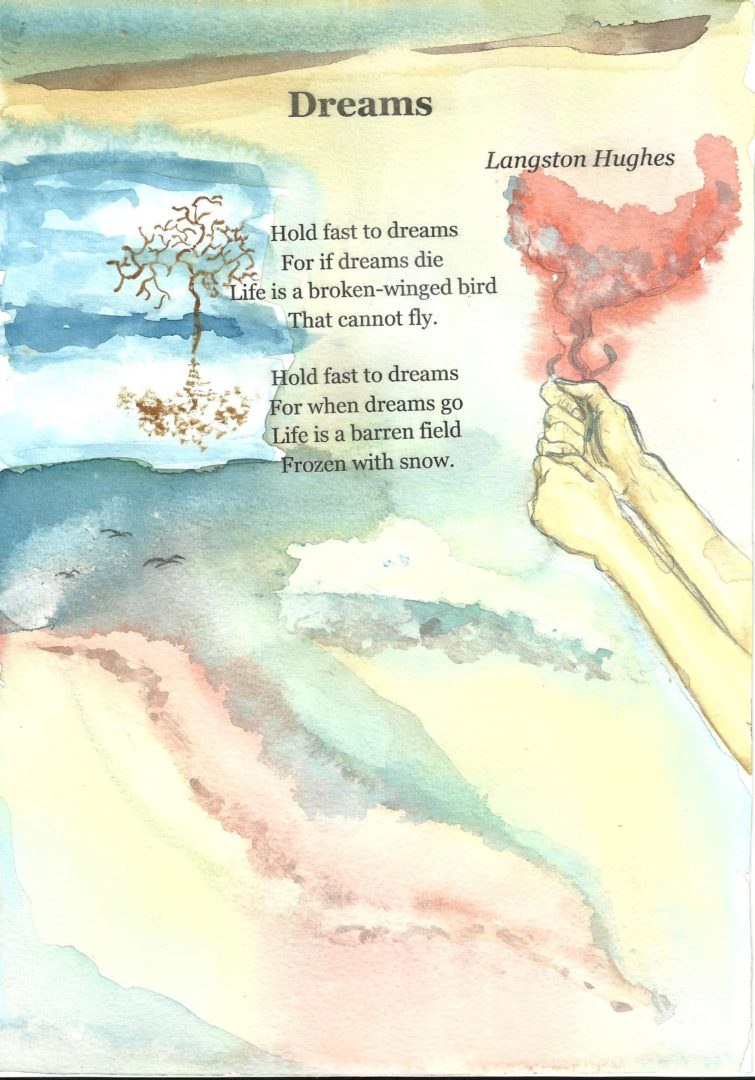This short poem by Langston Hughes seeps meaning and depth through its simplicity alone- its straightforwardness and clarity engages readers of all ages to wander with their minds into the topic the poet is discussing: dreams. The word “dreams” here refers to long-term goals- places to be or things to achieve by a certain time, and while the lives we live today are very rushed and reality-based, dreams are just as important as ever, if not increasingly so.
Dreams, according to Hughes, are crucial things to “hold fast to”; otherwise life tends to take a turn downhill. This urgency is expressed through the poem’s length and structure as well as its language. “Hold fast to” is a command (given by a person with experience), and implies that dreams are physical objects that we must cling to- thus making dreams a lot more serious than we’d like to think. This links to a quote said by the Cheshire Cat from Alice in the Wonderland in the following scenario:
Alice asked the Cheshire Cat, who was sitting in a tree, “What road do I take?”
The cat asked, “Where do you want to go?”
“I don’t know,” Alice answered.
“Then,” said the cat, “it really doesn’t matter, does it?”
If you have no goals- no ambitions- no dreams, then, like the Cheshire Cat slyly suggested, you won’t know where you’re going or how you’ll get there- and it won’t matter! This dangerous dilemma clears up the vitality of dreaming- and knowing yourself well enough to dream fearlessly in order to reach your fullest potential.
“Dreams” in this poem were also given life, likened to a bird and a field, with the ability to “die” and “go”, due to people’s loss of faith or developing minds. It is almost impossible to find a person with dreams that haven’t changed since they were a kid- for example, a six year old who dreamed of growing up to become a princess might, when she is older, channel her enthusiasm into a different path, like becoming a veterinary due to her change in interests. That is expected and good. The damage begins when perfectly capable people like you and me doubt themselves and are convinced that they fall short of greatness. That is when “dreams die”, especially since they could’ve been reality.
Hopelessness, self-doubt and self-deprecation are among many self-destructive tendencies that can quite literally damage a human being so that their life is a “broken-winged bird that cannot fly”. The image created here is more than vivid. You can just picture the bird, shuffling in the dirt it doesn’t belong in, feathers matted with dust, looking at the sky wistfully, one wing up, flexed and ready while the other hangs limp, helpless and heavy- a burden. There is no solution to its life-long problem; it must learn to cope despite its dissatisfaction. There is no way it will fly again the same way there is no way your life will get itself off the ground and into the crisp air of success without a dream. A destination is necessary, and dreams are harmless ways to weigh your options- as long as you are willing to work for them.
Once again, the poet commands, “Hold fast to dreams”- this time because “when they go”, “Life is a barren field frozen with snow”. Langston Hughes brings to light once more that when dreams are let go of (without replacement or improvement), time on earth will be unproductive and immobile, stiff with the consequences forced onto it. Unproductive meaning that nothing useful, of worth or a sense of fulfillment will be accomplished- and immobile, like the broken-winged bird, refers to the numbness and boredom of not advancing or developing- career-wise or mentally, spiritually and emotionally. The “snow” symbolises coldness, nonchalance and handicappedness- as one cannot move easily when the ground below has been frozen and covered in a thick layer of snow. Field imagery is used so that fruitless and leafless trees come to mind, emphasising the extent to which one cannot achieve the basic pleasures of life without a dream.
The ability to dream is inside every one of us. All that needs to be done is a bit of self-exploration: find what you are willing to commit yourself to, walk towards it with all that you have and don’t look back, bearing in mind that it is worth setting goals for your personal development and not just for your work-life.


